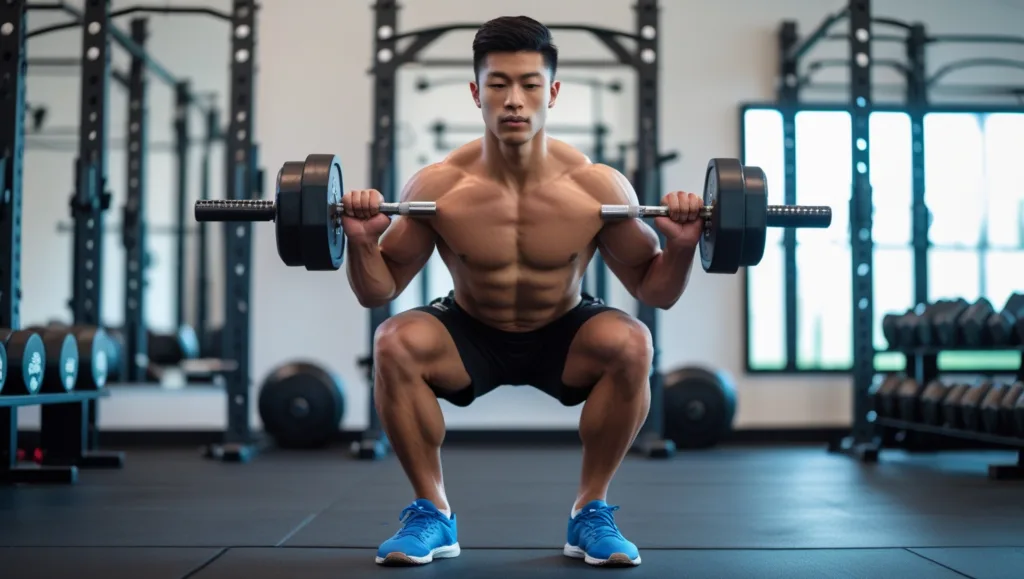The PowerBlock goblet squat is a powerful and versatile exercise that strengthens the legs, glutes, and core while improving overall functional fitness. This squat variation utilizes a PowerBlock adjustable dumbbell, which provides a convenient way to increase resistance without switching between multiple weights. Whether you’re a beginner or an advanced lifter, incorporating the PowerBlock goblet squat into your routine can lead to improved lower-body strength, better squat mechanics, and enhanced mobility.
PowerBlock Goblet Squat
Table of Contents
Benefits of PowerBlock Goblet Squat
The PowerBlock goblet squat is more than just a leg workout—it offers multiple benefits that can enhance your overall fitness. Here’s why you should add it to your routine:
- Strengthens Lower-Body Muscles: This squat variation targets the quadriceps, hamstrings, glutes, and calves, making it a comprehensive lower-body exercise.
- Improves Core Stability: Holding a weight in front of your chest forces your core muscles to engage, improving balance and reducing the risk of back injuries.
- Enhances Mobility and Flexibility: The PowerBlock goblet squat encourages a deep squat position, increasing hip and ankle mobility over time.
- Reduces Stress on the Lower Back: Unlike barbell squats, this variation places less strain on the spine, making it an excellent option for those with back concerns.
- Convenient and Adjustable: PowerBlock dumbbells allow for quick weight adjustments, making it easy to progress in strength without needing multiple dumbbells.
How to Perform the PowerBlock Goblet Squat with Proper Form
Proper form is crucial to maximizing the benefits of the PowerBlock goblet squat while minimizing injury risks. Follow these steps:
- Starting Position:
- Select an appropriate weight on your PowerBlock dumbbell and hold it with both hands at chest level, keeping your elbows close to your body.
- Stand with your feet shoulder-width apart, with your toes slightly pointed outward.
- Keep your chest up and core engaged to maintain an upright posture.
- Descending Phase:
- Push your hips back and lower your body by bending your knees, ensuring your chest stays upright.
- Keep your knees aligned with your toes and descend until your thighs are at least parallel to the ground.
- Maintain a neutral spine and avoid rounding your back.
- Ascending Phase:
- Press through your heels to push your body back up to the starting position.
- Engage your glutes and quads as you extend your hips and knees.
- Keep the dumbbell stable at chest level throughout the movement.
- Breathing Technique:
- Inhale as you lower yourself into the squat.
- Exhale as you push through your heels and return to the starting position.
Common Mistakes to Avoid
Even though the PowerBlock goblet squat is a beginner-friendly movement, certain mistakes can reduce its effectiveness and lead to discomfort. Here are some common errors to watch out for:
- Leaning Too Far Forward: Keep your chest lifted and maintain an upright posture to prevent unnecessary strain on the lower back.
- Allowing Knees to Cave Inward: Your knees should track in line with your toes throughout the movement to avoid joint stress.
- Not Squatting Deep Enough: Aim to reach at least parallel to the ground to fully engage the glutes and hamstrings.
- Holding the Weight Incorrectly: Keep the PowerBlock dumbbell secure at chest level to maintain balance and stability.
- Using Too Heavy a Weight: Start with a manageable weight and progressively increase resistance as you build strength and confidence.
PowerBlock Goblet Squat Variations for Progression
Once you master the PowerBlock goblet squat, you can modify the movement to target different muscle groups and add variety to your workouts:
- Tempo Goblet Squat: Slow down the lowering phase to increase time under tension, enhancing muscle activation.
- Pause Goblet Squat: Hold the squat at the bottom position for 2-3 seconds to improve strength and control.
- Goblet Squat to Press: After squatting, press the dumbbell overhead to engage the shoulders and triceps.
- Elevated Heel Goblet Squat: Place small plates under your heels to increase quad engagement and improve squat depth.
- Sumo Goblet Squat: Widen your stance and point your toes outward more to emphasize inner thigh and glute activation.
Conclusion
The PowerBlock goblet squat is an excellent exercise for building lower-body strength, improving mobility, and enhancing overall stability. With proper form and progressive overload, this movement can help you achieve better squat mechanics and prevent injuries. Whether you’re training at home or in the gym, incorporating this squat variation will take your leg workouts to the next level. Try different variations and increase resistance gradually to continue challenging your muscles and maximizing gains.




